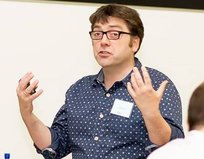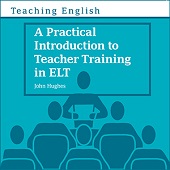10 questions about A Practical Introduction to Teacher Training in ELT
 Packed with practical advice, training tips, and workshop ideas, A Practical Introduction to Teacher Training in ELT is the latest title from author John Hughes.
Packed with practical advice, training tips, and workshop ideas, A Practical Introduction to Teacher Training in ELT is the latest title from author John Hughes.
Here, John gives us 10 answers to questions about his latest book.
1. Where did the idea to write A Practical Introduction to Teacher Training in ELT spring from?
I’m often asked by teachers how they should get into teacher training or I’ve helped people such as Senior Teachers or Directors or Studies to support their teaching staff. So there seemed to be a need for this kind of introductory title.
2. How did you go about writing the book?
Actually, it started out as a blog. I set up a blog a few years ago for teacher trainers in ELT called www.elteachertrainer.com. There was so much online for teaching English but resources for teacher trainers were (and still are) quite limited. As I’d spent many years training both new and experienced teachers, I had a lot of resources I wanted to share on my blog. Eventually, it seemed to make sense to turn it into a book as well.
3. Who have you written the book for?
Many teachers want to get into teacher training so it’s partly in response to them. And it isn’t always very experienced teachers who become trainers. Even teachers who have only been teaching for a year or so can end up mentoring a new colleague or leading workshops for peers. For these types of trainers there are very few resources to guide them through the basics of teacher training. So my book is a useful start for any teacher entering into teacher training.
4. What did you learn from writing your book?
That writing a blog is not as hard as writing a book! It’s easier to write a short blog post on a day when you feel like it or feel you have something to say. Also blog posts receive immediate feedback in terms of the number of hits, comments and likes you receive. Book writing feels much more solitary and to sustain ideas over 200 pages is harder work.
5. What advice do you have for teachers planning to move into teacher training?
Stop planning and do it. By that I mean, I think teacher training happens at many levels. You don’t have to wait until you’re asked to run a training course like a CELTA or Cert TESOL for example. Many schools have internal staff training workshops when teachers share ideas. So volunteer to present something to your peers that you’ve recently tried in class. Even a short 15 minutes presentation or workshop is a great way to build up your experience of what it’s like to train and help develop other teachers.
Training even happens informally at a day-to-day level in teacher’s rooms around the world. We’ve all been sitting during breaks between lessons and said to a colleague: ‘Hey I’m really stuck for ideas today’. The colleague suddenly comes up with a list of ways to help. That’s often how our experience of training begins.
6. You recently spoke at Language Show Live on tips for observing English language lessons. What was the main point of the talk?
I was promoting the idea of both observing your peers to get ideas from them and to support them but also to use technology to observe your own lessons.
7. What kind of technology can you use to observe your own lessons?
For example, you can use the camera on your phone to take photographs of your whiteboard every twenty minutes and then reflect on your management of the board over the period of a lesson. Or record what you say and then transcribe your use of language in order to analyse how you give instructions or to study how you elicit ideas from a class. With the access to technology that we have nowadays, it’s easier than ever to observe yourself.
8. Isn’t recording your lessons with cameras and video quite intrusive in the classroom?
It can be but I think we live in such a selfie-culture, that taking an image or video recording something has become a norm. It makes reflecting on what happened in a lesson much easier to do and is a way of training yourself.
9. Who would you recommend ELT teachers follow for tips on teacher training?
Nowadays there are more and more people blogging about teacher training or on matters related to training. Bloggers like Sandy Millin and Anthony Gaughan at regularly write about teacher training issues.
10. What could someone who is interested in becoming a teacher trainer read next?
We are adding more and more articles on MyEtpedia for teachers and trainers. Take a look at Sandy Millin’s tips on becoming a teacher trainer.
Find out more information on the latest title from John Hughes by clicking A Practical Introduction to Teacher Training in ELT.
Comments
Write a Comment
Comment Submitted